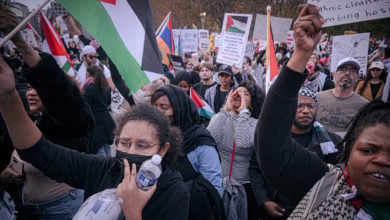The plight of immigrant Indian workers who were deceived into virtual slavery has brought attention to the vile practice of human trafficking.
|
The promises were all lies. Instead of receiving permanent legal status, the workers—who had paid fees of up to $20,000 to Signal—received 10-month H-2B temporary worker visas.
The workers were essentially trapped, and their employers knew it. Their documents were stolen and wages were withheld. For all practical purposes, slavery had returned to Louisiana.
Those who dared organize to fight back faced deportation. Signal International sent armed guards on pre-dawn raids, illegally detaining workers and plotting in collusion with local police to deport them.
Unwilling to let themselves be broken by Signal’s intimidation tactics, several of the workers chose to escalate the struggle rather than surrender. They headed from Louisiana to Washington, D.C., covering much of the route on foot, to protest their work conditions.
Workers have since rallied in front of the U.S. Department of Justice building, and several went on hunger strikes to bring attention to their fight. They sought support at the Indian embassy, but got little more than sympathy. The Indian government was reluctant to press Washington to address the blatant injustice done to the workers deceived by Signal International.
The inhumane treatment faced by these Indian immigrants, though shocking, is hardly unique. The workers gained some public attention by organizing and fighting back, but unfortunately they are just a microscopic fraction of the victims of human trafficking.
The U.S. Department of Justice estimates that more than 800,000 people are trafficked across international borders every year, with an estimated 18,000 to 20,000 coming into the United States. The real figures could be much higher.
This modern-day slavery takes many forms. Women and young girls are sold into prostitution. Farm workers are manipulated into debt they can never pay, thus becoming de facto slaves. Children are sold, to work long hours in sweatshops.
Major U.S. corporations such as Nike and The Gap have been repeatedly implicated in connection with extremely exploitative working conditions.
From Florida to Baghdad
In southwest Florida, slavery exists in plain sight. Workers are enticed to enter the United States with promises of jobs in hospitals and hotels, according to Anna Rodriguez, president of the Florida Coalition Against Human Trafficking.
Most of the workers enter the country with J-1 visas, given to students or training recipients, or H-2 temporary worker visas. They are lured by promises of jobs paying $15 to $25 an hour. The traffickers, often charging exorbitant “recruitment fees,” quickly manipulate them into debt, at which point the workers are trapped.
The victims are brought into the United States by employment agencies that are subcontracted by hotels and hospitals eager to take advantage of cheap labor. The beneficiaries are thus not only individual traffickers but also the businesses that reap extra profits from slave labor. Modern-day slavery is not the result of isolated cases involving individual criminals. Rather, it is the most extreme manifestation of systematic capitalist exploitation of labor.
Perhaps some of the most egregious examples of slave labor have been in charges lodged against companies that are building the U.S. embassy in Baghdad.
Foremen from First Kuwaiti General Trading & Contracting affirmed that workers from India, Pakistan, the Philippines and other Asian countries were routinely beaten, denied medical care and forced to live in squalid conditions. The Department of State had awarded First Kuwaiti the contract to build the embassy.
“Every U.S. labor law was broken,” John Owens, a foreman for the company, charged. He resigned in disgust after seven months.
An April 19, 2006, Pentagon memo acknowledged that contractors in Iraq and Afghanistan often took away workers’ passports in direct violation of U.S. labor laws. The practice obviously leaves foreign workers, who are underpaid and far from home, at the mercy of the bosses.
Contractors in Iraq and Afghanistan, many of them working as subcontractors for Halliburton/KBR, used deceptive bait-and-switch hiring practices. They also charged high recruiting fees, thus driving the poorly paid workers into insurmountable debt.
Injured workers in need of treatment were simply given powerful pain medication and sent back to work. Such practices were commonplace in the U.S. “Green Zone” in the heart of Baghdad—a disregard for workers’ well-being that is grotesquely fitting given the U.S. imperialist designs for the region.
The bosses who reap the profits often maintain a veneer of plausible deniability by having subcontractors do the dirty work of trapping workers into slave-like conditions.
When cases become public, their spokesmen profess innocence or regret, but the practice persists—because the profit motive remains.






